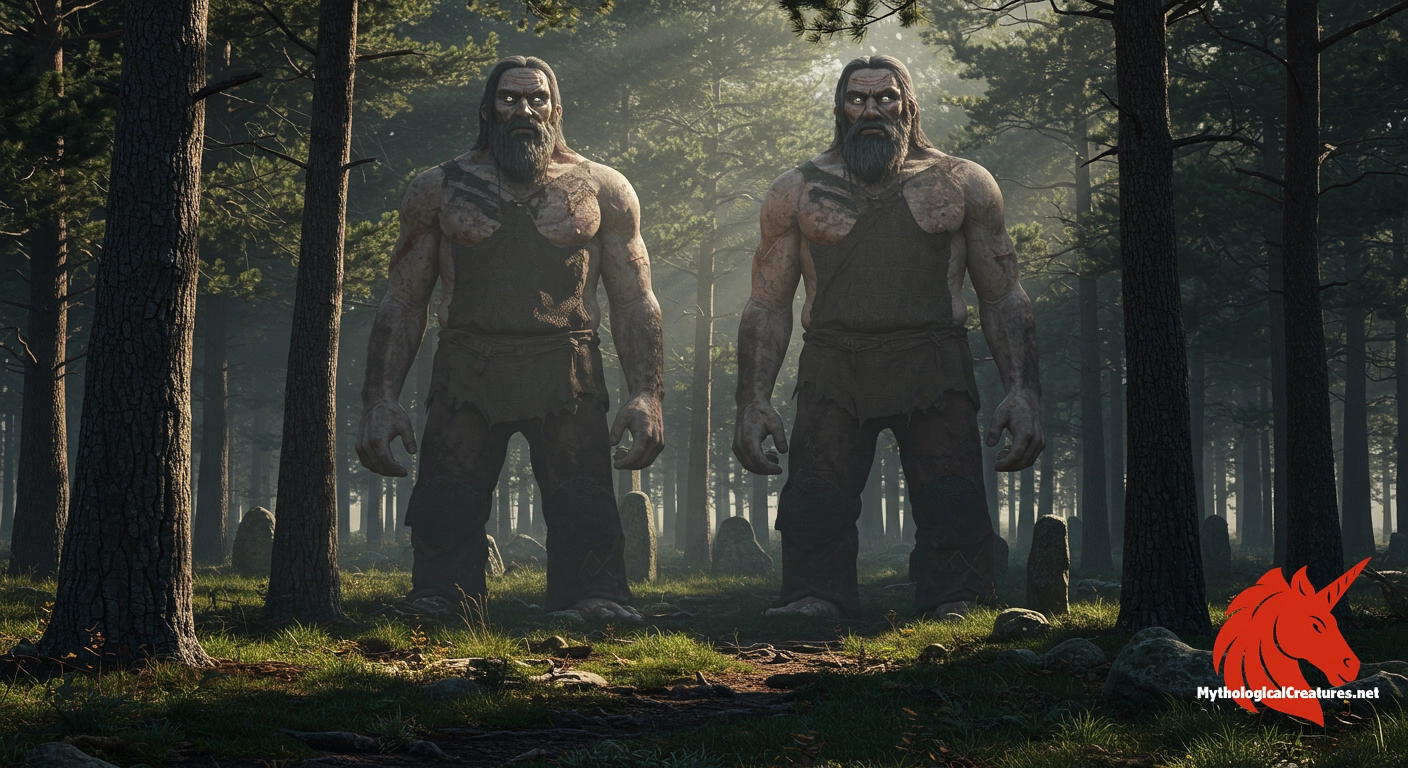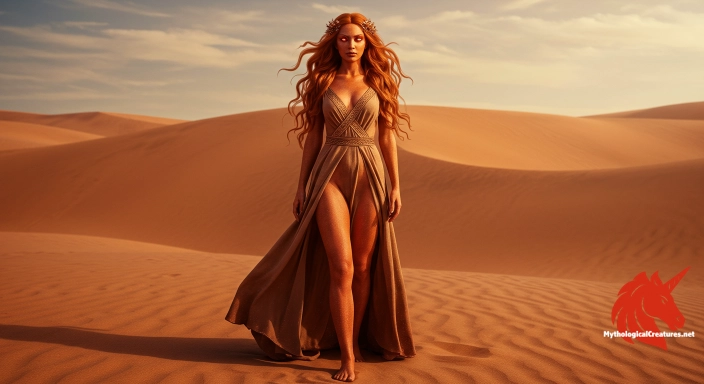Ellert and Brammert: Ellert and Brammert are legendary giants from Dutch folklore known for robbing travellers in Drenthe, Netherlands.

Ellert and Brammert
Ellert and Brammert - They serve as cautionary figures in Dutch folklore, symbolising the dangers lurking in the rural landscapes of Drenthe.
Origins & First Encounters
Ellert and Brammert emerge from the mists of Dutch folklore as towering figures whose legend has captivated generations in the province of Drenthe. Their story is rooted in a time when the wild expanses of the Dutch countryside gave rise to larger-than-life characters. They were reputed as giants who roamed the rural roads, challenging and robbing unwary travellers, and their notoriety became woven into the fabric of local cultural identity. The exact origins of their tale are lost in the shadowy depths of oral tradition, where harsh living conditions and unpredictable nature inspired tales of fear and awe. Over time, the narrative of these giant bandits has evolved from cautionary myth to a celebrated part of regional heritage. Their legend, passed down through generations, reflects a time when nature and the human struggle to tame it were central to everyday life. The folklore surrounding them is rich with symbolism, reflecting the chaotic power of the untamed wilderness and the human condition. The establishment of a museum bearing their name reinforces their role as important cultural icons, immortalising their story for future generations.
Source Texts & Tale Variants
The early accounts of Ellert and Brammert primarily exist in the realm of oral tradition, where local storytellers handed down their exploits through vivid narrative recitals. Over the centuries, fragments of their legend were eventually recorded by folklorists and chroniclers who sought to capture the essence of Drenthe’s mythic past. Although there are no surviving ancient texts devoted solely to them, later manuscripts and regional anthologies include mentions of their deeds amidst tales of rural mystery. Variants of their story have been collected from different communities, each adding its own nuances to the narrative. Some recitations depict them as ruthless outlaws, while others hint at underlying themes of tragedy and misfortune. The museum devoted to their memory has also served as a repository of disparate accounts, preserving local artefacts and written records that compliment the oral tradition. Modern folklore research has aimed to reconcile these variant stories, highlighting how different storytellers emphasise aspects of fear, respect, or even melancholy. The dynamic nature of their narrative demonstrates how folklore is ever-changing, adding layers of complexity to the myth of Ellert and Brammert.
Form & Powers
Descriptions of Ellert and Brammert often invoke the awe-inspiring imagery of colossal beings whose physical presence dominated the landscape. They are typically portrayed as giants with immense strength, their height and bulk suggested as being as imposing as the tallest pine trees in the ancient Drenthe forests. Their faces are depicted with rugged features, marked by deep lines and scars that tell tales of violent encounters and arduous journeys. Thick locks of coarse hair and intense, penetrating eyes enhance the sense of wild ferocity attributed to them. In some versions of the legend, their bodies bear the rugged signs of a life spent battling both nature and man, with calloused hands and weathered skin. Illustrations and later artistic renditions amplify these attributes, showing them in attire that is primitive, sometimes draped in tattered animal hides that evoke the rawness of the untamed wilds. Variations in size are noted between different accounts, with some traditions suggesting that they almost melded with the natural features of the land. Their formidable physicality not only served to instil terror in passing travellers but also symbolised the indomitable force of nature itself.
Regional Faces
The legend of Ellert and Brammert is deeply interwoven with the geographical and cultural landscape of Drenthe, yet regional variations have allowed their myth to take on multiple distinctive flavours. In the rural communities of Drenthe, local landmarks are often tied to episodes in their story, with hills and ancient trees being attributed as silent witnesses to their exploits. In neighbouring areas, subtle alterations in the narrative portray one of the giants as perhaps more sympathetic or tragic than the other. Some local traditions render them as cursed figures, ensnared in fate rather than merely as malevolent robbers. The story adapts to the environmental context of each region, reflecting localized fears of both the wilderness and its hidden dangers. Fresher retellings in nearby provinces sometimes incorporate elements of magic, suggesting that their presence was accompanied by supernatural phenomena such as sudden mists or eerie silences in the forest. These regional adaptations have allowed the myth to be embraced by a wider audience, each community colouring the narrative with its own cultural values. The adaptability of the myth underscores its enduring appeal and its ability to resonate with diverse local experiences.
Cultural Parallels
The myth of Ellert and Brammert finds intriguing parallels with giant figures in other European folk traditions, such as the jotnar in Norse lore and the titanic beings of Celtic legends. Unlike some mythic giants who are solely portrayed as benevolent forces of nature, Ellert and Brammert embody a duality, mixing fearsome aggression with an echo of tragic destiny. Their depiction shares similarities with other outlaw giants who serve as cautionary figures in a landscape where human frailty meets the unbridled might of the natural world. Like many counterparts in European myth, they straddle the line between human and monster, often symbolising societal anxieties about the uncontrollable forces of nature and the dangers of venturing into the unknown. Comparative folklore reveals that while the narratives differ in detail, the underlying theme of formidable beings rising from the wilderness remains consistent across cultures. The duality of their portrayal has been compared to various folk heroes whose stories are equally parts celebration and warning. In Europe, giants are often emblematic of both the beauty and terror of nature, a feature that clearly resonates in the legend of Ellert and Brammert. Their cross-cultural connections highlight a shared human fascination with the boundary between civilisation and the wild.
Legacy & Modern Evolution
The transformation of the Ellert and Brammert narrative over the centuries underscores its unique place in Dutch cultural heritage. Initially passed on as a stark warning to travellers, their legend has evolved into a rich cultural symbol representing the tumultuous interplay between man and nature. In modern times, the giant figures have been reimagined in literature, art, and even local theatre, where they are celebrated for their larger-than-life personas as much as for the cautionary lessons they impart. The museum dedicated to their memory in Drenthe has played a pivotal role in recontextualising the myth, linking the past with present cultural identity. Contemporary reinterpretations have softened some of the darker elements of the folklore, infusing the story with both nostalgic charm and an appreciation for its historical roots. In popular culture, their image has often been used to evoke a sense of mystery and adventure, bridging the gap between ancient myth and modern storytelling. Their legacy is reflective of a broader trend in cultural heritage preservation, where old legends are revitalised to celebrate regional uniqueness. The continued fascination with Ellert and Brammert exemplifies how myth can be an enduring medium through which communities interpret their history and identity.
Interesting Fact
Despite their notorious reputation as robbers, some local narratives suggest that Ellert and Brammert were complex figures, with aspects of their story hinting at the harsh social realities of their era.
Quick Creature Info
Origin:
Features:
Associations:
Our Mythic Legendary Rating:

Habitat:
Supernatural Powers:
Physical Attributes:
Abilities:
Behavior:
Weaknesses:
Lore:
References
Discover Another Mythical Legend You May Not Have Heard Of?
Uncover the mysteries of ancient folklore and expand your knowledge of legendary beings from cultures around the world.
Dare to Meet the Sandraudiga....
Curated by the Mythological Creatures Team (rev. May 2025)
